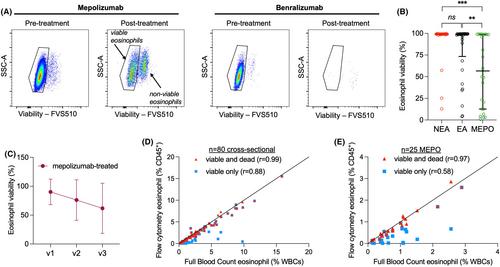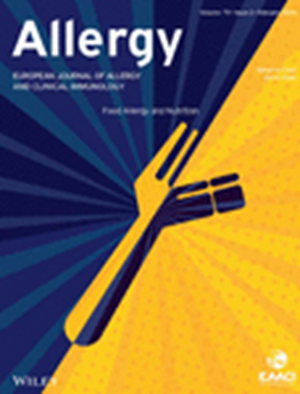Mepolizumab depletes inflammatory but preserves homeostatic eosinophils in severe asthma
Abstract
Background
Eosinophils are key therapeutic targets in severe asthma that are suppressed by IL5 (mepolizumab) and IL5 receptor (benralizumab) blockade. The effect of IL5 pathway biologics on recently described homeostatic (hEOs) and inflammatory (iEOs) eosinophil subsets is unknown. We aimed to determine the relative impact of mepolizumab and benralizumab treatment on eosinophil subset and phenotype, and explore clinical associations of eosinophil subsets with severe asthma characteristics and treatment response.
Methods
We performed a cross-sectional observational study of severe asthma (eosinophilic n = 32, non-eosinophilic n = 23, mepolizumab-treated n = 25), with longitudinal follow-up of 30 eosinophilic participants at two timepoints (4–24 weeks, >24 weeks) post-commencement of mepolizumab (n = 20) or benralizumab (n = 10). Blood hEOs and iEOs were measured by flow cytometry assessment of surface CD62L protein.
Results
iEO proportion was significantly lower in mepolizumab-treated participants in both the cross-sectional and longitudinal study. Mepolizumab and benralizumab depleted iEOs to a similar extent, however a significantly greater number of hEOs remained in mepolizumab participants at follow-up. Greater iEO proportion correlated with poorer asthma control in eosinophilic but not non-eosinophilic asthma. Higher residual iEO proportion correlated with poorer asthma control in mepolizumab-treated individuals. Reduced blood eosinophil viability was observed in around half of mepolizumab-treated participants, which was associated with significantly better asthma control and spirometry.
Conclusions
Mepolizumab depletes iEOs and reduces circulating eosinophil viability in severe asthma but preserves a residual population of circulatory hEOs. In contrast benralizumab depleted both iEOs and hEOs. Higher iEO abundance and eosinophil viability are associated with poorer clinical outcomes following mepolizumab-treatment. Monitoring circulating eosinophil phenotype and viability may be useful to predict biologic treatment response in severe asthma.


 求助内容:
求助内容: 应助结果提醒方式:
应助结果提醒方式:


